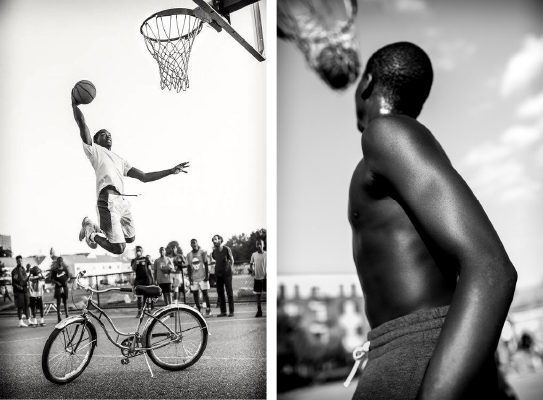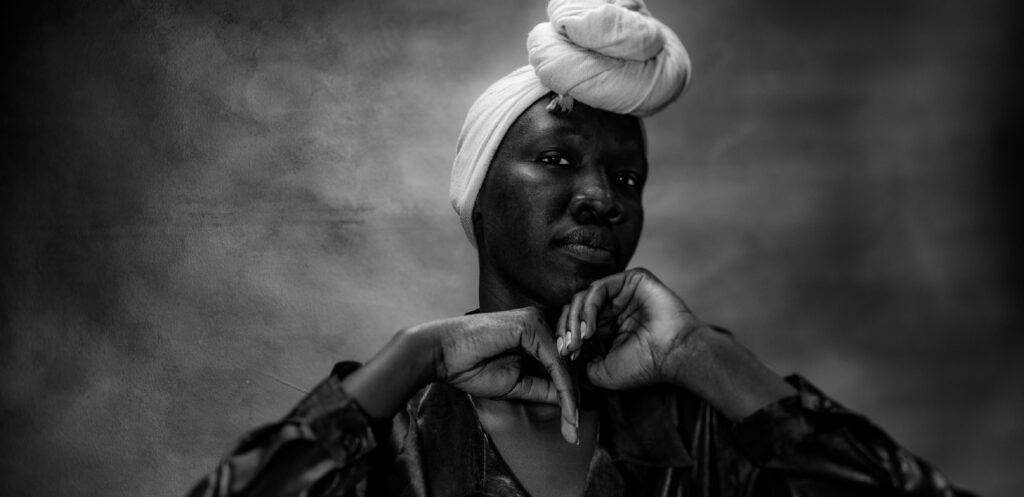
Séan Alonzo Harris
In The Embrace of
Technique and Tradition
Séan Alonzo Harris is a fine arts photographer, commercial photographer, photo historian, and curator. This short essay will investigate Harris’ unique contribution as a fine arts photographer, especially his developments within the craft of photography. In order to more clearly articulate his visual vocabulary, Séan produces portfolios rather than individual images, thereby allowing us to analyze and appreciate the cumulative impact of his images as well as their internal narratives. He selects his portfolio themes from his historical and social environments, such as everyday incidents he has seen, read, or heard about, or activities he has personally been involved with. Moreover, these occurrences must resonate with Séan’s artistic sensibilities and represent the photographic tradition along with the African American social and historical cosmos.
Quite often Séan’s portfolio themes represent personal homage to emblematic artistic monuments or individuals in the African American tradition. For example: his series The Space Between is an homage to Invisible Man, the iconic novel by Ralph Ellison; his I Am Not A Stranger portfolio improvises on the “I Am A Man” theme of the Civil Rights Movement of the 1960s; and his Voices In Our Midst exhibition is about gentrification in the US, as well as the universal need of human beings to be seen, heard and respected. Voices is also a tribute to the great Harlem photographer James Van Der Zee and the exhibit James Van Der Zee On My Mind.

Séan learned photography formally; however, unlike most photographers, he developed his craft in order to fulfill his visual ideas, not as an accompanying aspect of learning photographic technique. He began taking photos at seven years old with a borrowed family camera. At nine, he started using a 110mm disposable camera, but was quickly dissatisfied with his images, which he felt were washed out. This was especially problematic since, even at that early age, Séan was interested in the visual quality of black skin. At ten, this aspiration for an improved image led to the purchase of better equipment and the desire to learn darkroom technique so as to control the process.
At age eleven, a chance encounter at the Ferranti-Dege Camera Shop in Harvard Square with an unidentified photographer was instructive and important for Séan’s development. After reviewing his photographs, Séan asked him, “Why do your photos look so good?” The discussion that followed elevated Séan’s standards in terms of professional equipment and introduced him to the science of photographic sensitometry. A little later, while now working at that same camera store, he upgraded his camera to a Nikkormat and borrowed professional Nikkor lenses. When he was fifteen, his early photograph of his father and sister won a prize, the James Van Der Zee Black Heritage Award. Award notwithstanding, Séan was annoyed and perplexed; black skin tones continued to look washed out and still lacked texture or detail.
At this time, he made his most important discovery regarding the accepted photographic conventions or sensitometry: the photographic 18% gray scale standard, used for all exposures with cameras or light meters, was based on the average reflectance of white skin. Séan now knew that he had to create a personal photographic process for using black and white films to accurately capture, and, most importantly, celebrate, black skin. To get the skin tones he wanted, Séan began experimenting with different films, exposure times, developers, dilutions, and processing times. He aimed to use exposure and developing times to produce denser negatives, giving him room to manipulate tones in the darker shadow areas of the image where you would find the details of dark black skin.

Another foundational experience in Séan’s artistic development was studying with Bruce Kench in a class at the Art Institute of Boston/Lesley School of Art and Design. Prof. Kench taught Séan how to experiment with all the different complimentary factors of the photographic process. This allowed him to understand how to control variables and fine-tune them for a desired result.
For me, it is in his portraits where Séan’s technique and artistry literally and figuratively shine, where his embrace of technique and tradition blossomed into a personal artistic vision. Séan’s desire to develop his technique in order to “get black skin right” helped him to learn from artists like Kerry James Marshall about “the beauty, brilliance, humanity and power of black skin,” which he hopes will lead to the acknowledgement of the place and validity of black people in history. In Séan Alonzo Harris’ words: “we were, and are, here” and “our convoluted history is just that, our history!”
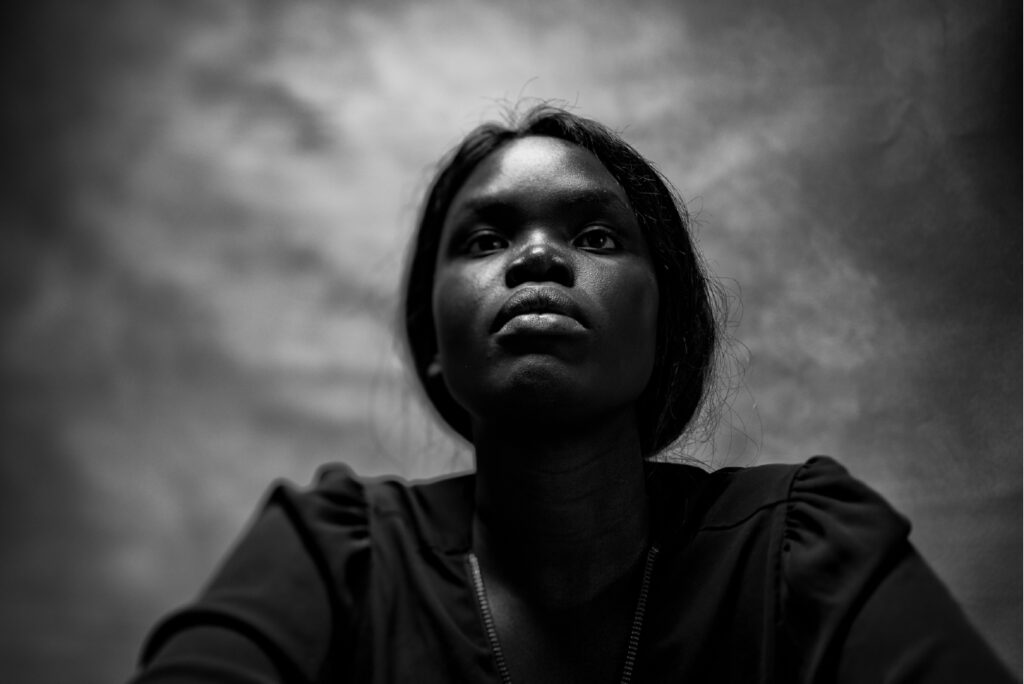
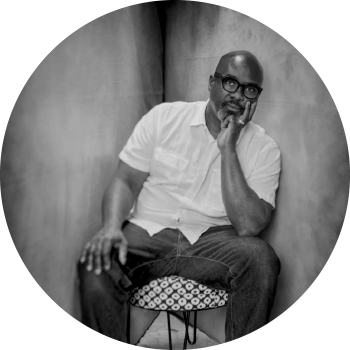
SÉAN ALONZO HARRIS
Séan Alonzo Harris is a professional editorial, commercial and fine
art photographer concentrating on narrative and environmental
portraiture. Over the past 25 years, Harris’s work has been featured in a
range of national publications, advertising campaigns, and exhibitions.
In these varied contexts, his work focuses on human experience and
identity and examines both how individuals visualize themselves
and how they are portrayed. Harris’s images bear witness to often
invisible or overlooked members of our communities, and create
portraits that provide a counter-image and narrative of self-worth and
personal agency. His work has been published in Atlantic Magazine,
the Paris Review, Boston Magazine, Maine Home and Design, Photo
District News Rising Star feature, Maine Magazine, Harvard University
Magazine.
Harris’s most recent solo exhibition at the Colby College Museum
of Art, I Am Not A Stranger, was developed in collaboration with
Waterville Creates and supported by a grant from the Maine Arts
Commission. He has developed several significant shows, VanDerZee On My Mind featuring images of African Americans in Maine, The Families Of Maine Documentary Photography Project; A Lebanese Family
In Waterville, Recollection; Green Memorial African Methodist Episcopal
Zion Church, the multi-disciplinary exhibition; If Wishes Were Horses,
Beggars Would Ride at the Portland Museum of Art, featuring video,
dance, text, and photography and The Griffin Museum of Photography’s
Tenth Annual Exhibition. Harris graduated from the Art Institute of
Boston and studied photography in Viterbo, Italy and at the Maine
Media Workshops in Rockport, Maine.
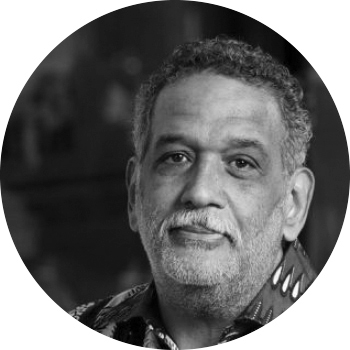
C. DANIEL DAWSON
C. Daniel Dawson is a photographer, curator, arts administrator, consultant, filmmaker, and scholar based in New York City. Dawson has exhibited work in over 35 shows and is an early member of the Kamoinge Workshop, an African American photography collective based in Harlem, New York. Dawson has served as Director of Special Projects at the Caribbean Cultural Center, the Program Manager at the American Museum of Natural History, the Curator of Photography, Film and Video at the Studio Museum in Harlem, and the Curatorial Consultant and Director of Education at the Museum for African Art. Dawson has also given lectures at Columbia University, Princeton University, the University of California-Berkeley, the New School for Social Research, the Federal University of Bahia and Rio de JaneiroBrazil, among many others. Additionally, he has taught seminars on African Spirituality in the Americas at Columbia University, the University of Iowa, New York University and Yale University.

